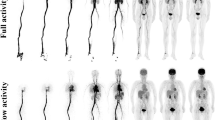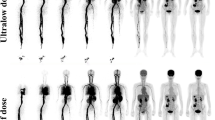Abstract
Objective
To explore the feasibility of ultralow-activity 18F-FDG total-body dynamic PET imaging for clinical practice in patients with lung adenocarcinoma.
Methods
Eight of 18 patients were randomly injected with 18F-FDG with full activity (3.7 MBq/kg) for total-body dynamic PET imaging, while 10 received one-tenth activity (0.37 MBq/kg). The generated time-to-activity curves (TACs) according to the regions of interest (ROIs) were processed by PMOD through standard FDG two-tissue compartment model fitting. The kinetic constant rates (K1, K2, K3, and Ki), radiation dose, prompt counts, and data storage size were analysed between the full- and ultralow-activity groups. The SUVmax-Tumour/SUVmax-Liver and SUVmax-Tumour/SUVmax-Muscle on static PET images were also assessed.
Results
Each of the fitted models has a satisfactory goodness-of-fit with R2 greater than 0.9 except 3 (3/234) in ultralow-activity group, where one in pancreas (R2 = 0.851), another one in muscle (R2 = 0.868), and the third one in bone marrow (R2 = 0.895). All the fitted models in the full-activity group had a better goodness-of-fit than those in the ultralow-activity group. However, no significant differences were found in any of the kinetic metrics or image quality between the two groups except in the reduction of radiation dose and data storage size.
Conclusions
The 10 × reduction of injected 18F-FDG could achieve comparable kinetic metrics and T/N ratios by total-body dynamic PET imaging in lung adenocarcinoma patients. Ultralow-activity total-body PET imaging is feasible for clinical practice in oncological patients without obesity, especially in dynamic PET scanning.






Similar content being viewed by others
References
Boellaard R, Delgado-Bolton R, Oyen WJ, et al. FDG PET/CT: EANM procedure guidelines for tumour imaging: version 2.0. Eur J Nucl Med Mol Imaging. 2015;42(2):328–54.
Fletcher JW, Djulbegovic B, Soares HP, et al. Recommendations on the use of 18F-FDG PET in oncology. J Nucl Med. 2008;49(3):480–508.
Bosch KD, Chicklore S, Cook GJ, et al. Staging FDG PET-CT changes management in patients with gastric adenocarcinoma who are eligible for radical treatment. Eur J Nucl Med Mol Imaging. 2020;47(4):759–67.
Broccoli A, Nanni C, Cappelli A, et al. Diagnostic accuracy of positron emission tomography/computed tomography-driven biopsy for the diagnosis of lymphoma. Eur J Nucl Med Mol Imaging. 2020;47(13):3058–65.
Alberts I, Hunermund JN, Prenosil G, et al. Clinical performance of long axial field of view PET/CT: a head-to-head intra-individual comparison of the biograph vision quadra with the biograph vision PET/CT. Eur J Nucl Med Mol Imaging. 2021;48(8):2395–404.
Viswanath V, Daube Witherspoon ME, Karp JS, et al. Numerical observer study of lesion detectability for a long axial field-of-view whole-body PET imager using the PennPET explorer. Phys Med Biol. 2020;65(3): 035002.
Xiao J, Yu H, Sui X, et al. Can the BMI-based dose regimen be used to reduce injection activity and to obtain a constant image quality in oncological patients by (18)F-FDG total-body PET/CT imaging? Eur J Nucl Med Mol Imaging. 2021;49(1):269–78.
Hu P, Zhang Y, Yu H, et al. Total-body (18)F-FDG PET/CT scan in oncology patients: how fast could it be? Eur J Nucl Med Mol Imaging. 2021;48(8):2384–94.
Zhang Y, Hu P, Wu R, et al. The image quality, lesion detectability, and acquisition time of (18)F-FDG total-body PET/CT in oncological patients. Eur J Nucl Med Mol Imaging. 2020;47(11):2507–15.
Cherry SR, Jones T, Karp JS, et al. Total-body PET: maximizing sensitivity to create new opportunities for clinical research and patient care. J Nucl Med. 2018;59(1):3–12.
Zhang X, Badawi RD, Cherry SR, et al. Theoretical study of the benefit of long axial field-of-view PET on region of interest quantification. Phys Med Biol. 2018;63(13):135010.
Cherry SR, Badawi RD, Karp JS, et al. Total-body imaging: transforming the role of positron emission tomography. Sci Transl Med. 2017;9(381):eaaf6169.
Surti S, Karp JS. Impact of detector design on imaging performance of a long axial field-of-view, whole-body PET scanner. Phys Med Biol. 2015;60(13):5343–58.
Tan H, Sui X, Yin H, et al. Total-body PET/CT using half-dose FDG and compared with conventional PET/CT using full-dose FDG in lung cancer. Eur J Nucl Med Mol Imaging. 2021;48(6):1966–75.
Liu G, Hu P, Yu H, et al. Ultra-low-activity total-body dynamic PET imaging allows equal performance to full-activity PET imaging for investigating kinetic metrics of (18)F-FDG in healthy volunteers. Eur J Nucl Med Mol Imaging. 2021;48(8):2373–83.
Warburg O, Wind F, Negelein E. The metabolism of tumors in the body. J Gen Physiol. 1927;8(6):519–30.
Gupta N, Gill H, Graeber G, et al. Dynamic positron emission tomography with F-18 fluorodeoxyglucose imaging in differentiation of benign from malignant lung/mediastinal lesions. Chest. 1998;114(4):1105–11.
Yang M, Lin Z, Xu Z, et al. Influx rate constant of (18)F-FDG increases in metastatic lymph nodes of non-small cell lung cancer patients. Eur J Nucl Med Mol Imaging. 2020;47(5):1198–208.
Romer W, Hanauske AR, Ziegler S, et al. Positron emission tomography in non-Hodgkin’s lymphoma: assessment of chemotherapy with fluorodeoxyglucose. Blood. 1998;91(12):4464–71.
Wahl RL, Zasadny K, Helvie M, et al. Metabolic monitoring of breast cancer chemohormonotherapy using positron emission tomography: initial evaluation. J Clin Oncol. 1993;11(11):2101–11.
Zhang X, Xie Z, Berg E, et al. Total-body dynamic reconstruction and parametric imaging on the uEXPLORER. J Nucl Med. 2020;61(2):285–91.
Zhang X, Zhou J, Cherry SR, et al. Quantitative image reconstruction for total-body PET imaging using the 2-meter long EXPLORER scanner. Phys Med Biol. 2017;62(6):2465–85.
Liu G, Xu H, Hu P, et al. Kinetic metrics of (18)F-FDG in normal human organs identified by systematic dynamic total-body positron emission tomography. Eur J Nucl Med Mol Imaging. 2021;48(8):2363–72.
Wahl LM, Asselin MC, Nahmias C. Regions of interest in the venous sinuses as input functions for quantitative PET. J Nucl Med. 1999;40(10):1666–75.
Akaihe H. A new look at the statistical model identification. IEEE Trans Automat Contr. 1974;19:716–23.
Akaihe H. An information criterion (AIC). Math Sci. 1976;14:5–9.
Schwarz G. Estimating the dimension of a model. Ann Stat. 1978;6(2):461–4.
de Geus-Oei LF, van Krieken JH, Aliredjo RP, et al. Biological correlates of FDG uptake in non-small cell lung cancer. Lung Cancer. 2007;55(1):79–87.
Kimura Y, Naganawa M, Shidahara M, et al. PET kinetic analysis –pitfalls and a solution for the Logan plot. Ann Nucl Med. 2007;21(1):1–8.
Schaefferkoetter JD, Yan J, Townsend DW, et al. Initial assessment of image quality for low-dose PET: evaluation of lesion detectability. Phys Med Biol. 2015;60(14):5543–56.
Wu Y, Feng T, Shen Y, et al. Total-body parametric imaging using the Patlak model: feasibility of reduced scan time. Med Phys. 2022;49(7):4529–39.
Funding
This study is supported by Shanghai Municipal Key Clinical Specialty Project (shslczdzk03401), Clinical Research Plan of SHDC (SHDC2020CR3079B), Science and Technology Committee of Shanghai Municipality(20DZ2201800), Special Fund for Clinical Research of Zhongshan Hospital, Fudan University(2020ZSLC63), The Youth Medical Talents-Medical Imaging Practitioner Program of Shanghai “Rising Stars of Medical Talent” Youth Development Program (SHWRS [2020]087), The National Natural Science Foundation of China (82001863), and the Shanghai Sailing Program (19YF1408200).
Author information
Authors and Affiliations
Corresponding author
Ethics declarations
Conflict of interest
The authors declare that there is no conflict of interests.
Additional information
Publisher's Note
Springer Nature remains neutral with regard to jurisdictional claims in published maps and institutional affiliations.
Rights and permissions
About this article
Cite this article
Lv, J., Yin, H., Yu, H. et al. The feasibility of ultralow-activity 18F-FDG dynamic PET imaging in lung adenocarcinoma patients through total-body PET/CT scanner. Ann Nucl Med 36, 887–896 (2022). https://doi.org/10.1007/s12149-022-01772-2
Received:
Accepted:
Published:
Issue Date:
DOI: https://doi.org/10.1007/s12149-022-01772-2




